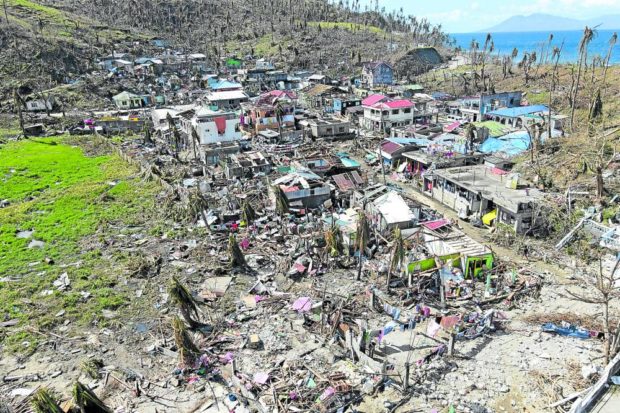Satellite phones can save lives during disasters, Zarate says

BATTERED COMMUNITIES Typhoon “Odette” (international name: Rai) leaves a trail of destruction in the village of Punta Bilar in Surigao City as it battered several regions in the Visayas and Mindanao before Christmas. —ERWIN MASCARIÑAS
MANILA, Philippines — After Typhoon Odette (international name: Rai) knocked down communication and power lines in several areas in Visayas and Mindanao, House Deputy Minority Leader Carlos Zarate said on Monday that satellite phones should become mandatory equipment for disaster response and preparedness, especially among storm-vulnerable local government units (LGUs).
As shown in the aftermath of Supertyphoon Yolanda (Haiyan) in 2013 and now Odette, the government could not rely solely on the infrastructure of telecommunication companies whose facilities in the affected areas were also down or heavily damaged, Zarate told the Inquirer on Monday.
“If media entities like ABS-CBN can make good use of satellite phones to bring accurate and timely information to our people in times of disaster or calamities, why can’t our government agencies or LGUs do the same?” he asked.
While satellite phones can be expensive, Zarate said that “for such a long-term investment, it may spell the difference between saving lives and properties as against sheer incompetence or criminal negligence.”
Death toll at 389
In fact, there was no need for a law requiring LGUs to buy satellite phones as they could simply add their procurement during the preparation and planning of their annual budget the same way cities and municipalities purchase rubber boats or modular tents for disaster response, he added.
Article continues after this advertisementAs of Monday, the reported number of deaths due to Odette was 389, according to the National Disaster Risk Reduction and Management Council (NDRRMC).
Article continues after this advertisementAnother 64 were still missing while 1,146 others were injured out of 4.2 million people affected by the typhoon in 11 regions.
Of the 389 fatalities, only 52 have been confirmed so far by the NDRRMC.
The NDRRMC situation report also placed the damage to infrastructure and agriculture at over P22 billion. Of the total, infrastructure damage accounted for P16.7 billion, with P12.8 billion in Caraga alone. Other regions that also reported damaged facilities were Mimaropa (Mindoro, Marinduque, Romblon, Palawan), Central Visayas, Eastern Visayas, Northern Mindanao and Soccsksargen.
On the other hand, agricultural damage in Calabarzon (Cavite, Laguna, Batangas, Rizal and Quezon), Mimaropa, Bicol, Western Visayas, Central Visayas, Eastern Visayas, Zamboanga Peninsula, Northern Mindanao, Davao region, Soccsksargen and Caraga was estimated at P6 billion with Odette destroying 288,677 hectares of agricultural land, killing a million livestock and poultry, and damaging thousands of agricultural facilities and equipment.
The Department of Agriculture has prepared P2.9 billion worth of financial assistance for affected farmers and fishers, including P1 billion worth of quick response funds for the rehabilitation of affected areas.
While telecommunication lines have been restored in 115 towns and cities, power has returned to only 154 of 284 localities in Mimaropa, Western Visayas, Central Visayas, Eastern Visayas, Zamboanga Peninsula, Northern Mindanao, Davao region, Caraga, and Bangsamoro Autonomous Region in Muslim Mindanao.
Health facilities damaged
The Department of Health (DOH), meanwhile, reported damage to 141 healthcare facilities in Mimaropa, Western Visayas, Central Visayas, Eastern Visayas, and Caraga regions as of Monday.
“We are utilizing our networks right now so that all patients needing access to services for health will be entertained, accommodated, and managed accordingly,” Health Undersecretary Maria Rosario Vergeire said in an online media briefing.
She added that the DOH and its centers for health development had mobilized P22 million worth of medicines, vitamins, family food packs, hygiene kits, water containers, and other commodities for typhoon-affected communities.
The Department of Budget and Management (DBM) said on Monday that P2 billion worth of quick response funds had already been released and another P4 billion was on the way following President Duterte’s pledge to raise P10 billion for Odette-hit areas.
Speaking at the Laging Handa public briefing, DBM officer in charge Tina Rose Marie Canda said the first P2 billion sourced from the President’s contingent funds was released to LGUs last week and on Monday for their affected constituents.
The additional P4 billion to be taken from converted calamity funds and other sources will be released before the end of the year.
According to Canda, the remaining P4 billion from the president’s P10-billion pledge will be available next year, under the new national budget that may be signed on Tuesday.
Presidential aspirant Manila Mayor Francisco “Isko Moreno” Domagoso has dispatched a 16-member team to Cebu City to help clear debris and provide potable water to affected communities.